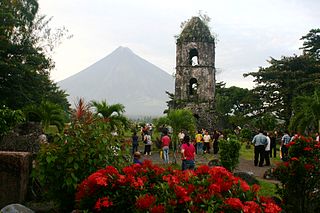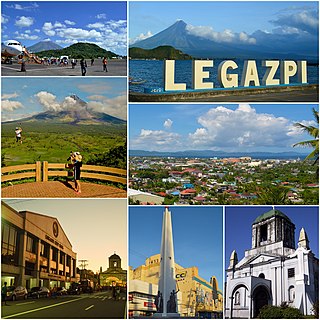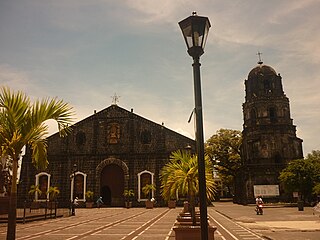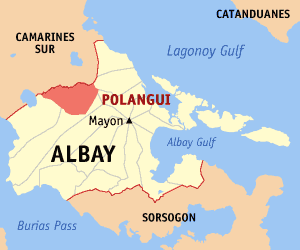History
Legazpi was opened on November 1914 as part of the Legazpi Division Line from Tabaco, Albay to Iriga, Camarines Sur. The pebbled station building was built in 1939 after the completion of the Manila-Legazpi Line.
The series of on and off operations of services can be dated back since 1941 during the arrival of the Japanese, rail tracks were destroyed as ordered by the USAFFE, interrupting services, the Japanese Imperial Army restored services on March 22, 1943, but to be halted again due to heavy damages brought by the liberation, services were once again restored on December 21, 1948.
The location of the railroad at the foot of Mayon Volcano often cause landslide and lahar floods which interrupt services, one was in 1976, services were restored on February 23, 1986, operations stopped again since February 2, 1993 due to the eruption of the Mayon Volcano, services were again restored on June 21, 1998 until the bridge at Travesia, Guinobatan was washed away in 2006.
The platform right side was raised in 2015 for the Bicol Commuter services.

Albay is a province located in the Bicol Region in southeastern Luzon of the Philippines.

The Bicol Region, also known simply as Bicol and historically known as Ibalong prior to Spanish colonization, is a region of the Philippines, designated as Region V. Bicol comprises six provinces, four on the Bicol Peninsula mainland – Albay, Camarines Norte, Camarines Sur, and Sorsogon – and the offshore island provinces of Catanduanes and Masbate.

Mayon Volcano, also known as Mount Mayon, or simply Mayon and Magayon, is a sacred and active stratovolcano in the province of Albay in Bicol Region, on the large island of Luzon in the Philippines. A popular tourist spot, it is renowned for its "perfect cone" because of its symmetric conical shape.

Legazpi, officially the City of Legazpi, and often referred to as Legazpi City, is a 1st Class component city and the capital of the province of Albay in the Philippines. According to the 2015 census, it has a population of 196,639. Legazpi is the regional center and largest city of the Bicol Region, in terms of population. It is the region's center of tourism, education, health services, commerce and transportation in the Bicol Region.

Legazpi Airport in the Philippines is a major airport in the Bicol Region, serving the vicinity of Legazpi, the capital city of Albay. It has a single runway with dimensions of 2280 x 36 meters, longer than those of the former airports of Bacolod and Iloilo City. The airport can handle medium-sized civilian jets and military aircraft. The airport will be replace by the new Bicol International Airport. Which will open on July 2020

The Philippine National Railways also known as (PNR) is a state-owned railway company in the Philippines, operating a single line of track on Luzon. As of 2016, it operates one commuter rail service in Metro Manila and local services between Sipocot, Naga City and Legazpi City in the Bicol Region. PNR began operations on November 24, 1892 as the Ferrocarril de Manila-Dagupan, during the Spanish colonial period, and later becoming the Manila Railroad Company (MRR) during the American colonial period. It became the Philippine National Railways on June 20, 1964 by virtue of Republic Act No. 4156. The PNR is an agency of the Department of Transportation.

Tabaco, officially the City of Tabaco or simply referred to as Tabaco City, is a 4th class city in the province of Albay, Philippines. According to the 2015 census, it has a population of 133,868 people.

Daraga, officially the Municipality of Daraga,, is a 1st class municipality in the province of Albay, Philippines. According to the 2015 census, it has a population of 126,595 people.

Malilipot, officially the Municipality of Malilipot,, is a 4th class municipality in the province of Albay, Philippines. According to the 2015 census, it has a population of 37,785 people.

Polangui, officially the Municipality of Polangui,, is a 1st class municipality in the province of Albay, Philippines. According to the 2015 census, it has a population of 88,221 people.
PBN Broadcasting Network, Inc. is a Bicolano commercial radio/TV broadcast media network that consists of one AM station, four FM stations and one television station. PBN Bicol is formerly affiliated with TV5 Network, Inc.

The Cagsawa Ruins are the remnants of a 16th-century Franciscan church, the Cagsawa church. It was originally built in the town of Cagsawa in 1587 but was burned down and destroyed by Dutch pirates in 1636. It was rebuilt in 1724 by Fr. Francisco Blanco, but was destroyed again, along with the town of Cagsawa, on February 1, 1814, during the eruption of the Mayon Volcano.

The Mayon Volcano Natural Park is a protected area of the Philippines located in the Bicol Region on southeast Luzon Island, the largest island of the country. The Natural park covers an area of 5,775.7 hectares, which includes its centerpiece Mayon Volcano, the most active volcano in the Philippines, and its adjacent surroundings. The volcano is also renowned for having an almost perfect cone. First protected as a National Park in 1938, it was reclassified as a Natural Park in the year 2000.
Lupi Viejo or Lupi is a defunct station situated on the Southrail Line of Philippine National Railways in Lupi, Camarines Sur.

The Philippine National Railways Metro Commuter Line is a commuter rail line operated by the Philippine National Railways, stretching from Tondo, Manila to the southern and northern edge of Metro Manila. Presently, there are 31 railway stations. The current line is colored orange on most maps.

Libmanan is one of the stations situated on the PNR Southrail Line. It is still use for the Bicol Express and Isarog Limited. The station serves the town of Libmanan, Camarines Sur.
Pili is one of the stations situated on the PNR Southrail Line in Pili, Camarines Sur. It is still use for the Bicol Commuter. The station served the town of Pili, Camarines Sur.

Typhoon Durian, known in the Philippines as Typhoon Reming, caused heavy damage across the island nation in November 2006. On November 30, 2006, Durian became the fourth typhoon equivalent to a Category 4 on the Saffir-Simpson scale to strike the Philippine island of Luzon, having earlier brushed the offshore Catanduanes. The storm crossed the country, but damage was heaviest in southeastern Luzon, particularly around the Mayon Volcano in the Bicol region. Intense rainfall affecting the volcano, estimated at around 600 mm (24 in), caused deadly lahars, or volcanic landslides. Six nearby villages were nearly destroyed, with thousands of homes washed away in minutes.
The Mayon Planetarium and Science Park also known as the Virtual Mayon Simulation and Observatory Facility is a planetarium and geology museum in the city of Tabaco in Albay, Philippines.
Daraga railway station is a station being famous for its videos for the Naga to Legazpi line.













